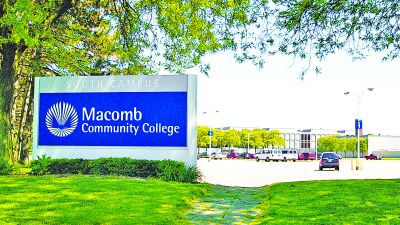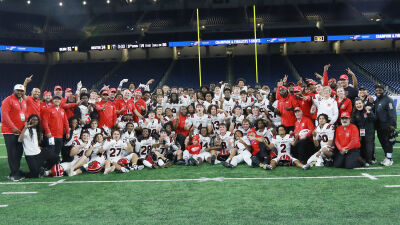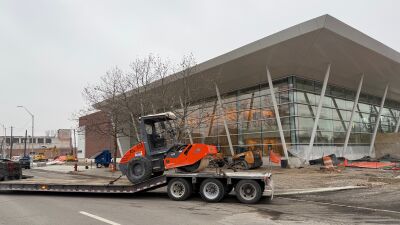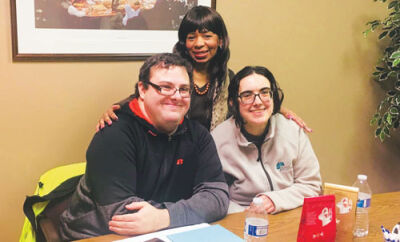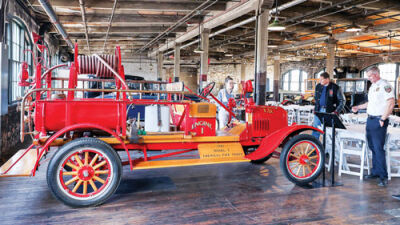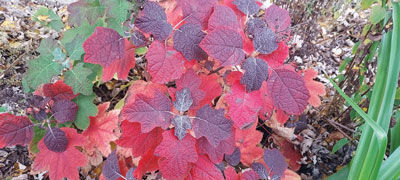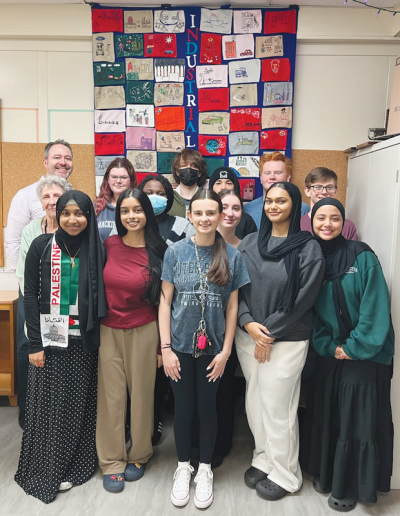
The Advanced Placement world history students in Jaime Bellos’ classroom at Center Line High School, as well as two other classes, studied the Industrial Revolution by making a quilt together. Teacher Jaime Bellos is pictured at the top left, and paraprofessional Paulette Nantais is standing in front of him.
Photo by Maria Allard
CENTER LINE — When studying the Industrial Revolution of the 1700s and 1800s, students in Jaime Bellos’ world history classes at Center Line High School were able to place themselves among the innovators of the time.
Using their creativity, they recently designed a quilt to depict what the Industrial Revolution looked like. Each student created an image of the historic time on paper. Using magic markers, hot glue, iron-on patches, sparkles and glitter, they transferred their drawings onto a square of fabric, which ultimately made the quilt.
The students used two methods of sewing. First, they sewed by hand to experience life before the Industrial Revolution. After a while, they switched to using a sewing machine, invented during and after the Industrial Revolution. The exercise demonstrated the difference between sewing with machinery and sewing by hand.
Hall monitor and guest teacher Cindy Andrews and special education paraprofessional Paulette Nantais showed the students how to sew properly.
Two world history classes and one Advanced Placement class participated in the unit. Many students had never sewn before. The quilt, as well as two others made in previous years, hang in Bellos’ classroom.
“Before the Industrial Revolution everything had to be sewn by hand: clothing, drapery, anything. It was a very hands-on unit for the kids,” said Nantais, who sewed together all the squares. “They saw the difference in how long it takes for them to hand sew versus the machine. They saw how tedious and time consuming it was. The kids used their imagination. There were some clever ones they came up with.”
The student’s artwork included factories, trains, families, farms and cities. On April 16, the students in the AP class talked about the project.
“I think it’s really beautiful,” senior Saul Winkler said of the quilt. “It’s a really unique way to learn (about) history. I found it very interesting.”
“It shows the advancements we had in the United States,” sophomore Irene Choudhury said. “It’s cool to see the different ideas people came up with and the different perspectives.”
Choudhury designed a human brain to illustrate the Industrial Revolution “because everyone was a critical thinker.”
“I thought it was pretty fun we learned about this,” sophomore Lindita Fetahu said. “We got to do it in a creative way.”
Sophomore Judah Sibila used his creativity to show how everyone was able to celebrate Christmas during the Industrial Revolution with the advances that had been made.
“I really liked the creative aspect of getting to use art and integrating it in our core curriculum,” sophomore Tazkia Zaman said. “(The project) showed me how everything advanced and got easier.”
Making the quilt brought back memories of elementary school for sophomore Aleena Ahmed.
“I liked the sewing part with the needles and remembered how thankful I should be with the Industrial Revolution,” she said. “I liked everybody’s perspective on it.”
Senior Patricia Wani shared her thoughts about how she thinks people responded to the Industrial Revolution at the time.
“I think people were afraid of losing their jobs because they didn’t want to move on,” she said.
“People didn’t want to change because they were farmers,” sophomore Farihah Islam said. “It’s pretty fun when we do stuff like this. I first did the hand sewing, and the sewing machine was quick and easy.”
Sophomore Cameron Ballard, whose picture was of a farm, thought about what would have happened without the Industrial Revolution.
“Every aspect of our lives would be different,” said Ballard, who also saw the differences between sewing by hand and with the sewing machine. “It’s really easier to use the machines than it is to do by hand.”
Sophomore Garrett Watters certainly appreciates the cars of the past and the work Henry Ford did to bring about the automobile assembly line.
“I think cars were a big part of the Industrial Revolution,” Watters said.
For sophomore Adia Nawrocki, making the quilt “opened my eyes on how thankful I am the Industrial Revolution happened.” And when working on the quilt, “the sewing machine made everything a lot easier.”
The project gave Jaclyn Kupraszewicz some insight into history.
“Before the Industrial Revolution, we had no need for big cities,” said Kupraszewicz, who thought making the quilt “was kind of a bonding experience” between the students.
 Publication select ▼
Publication select ▼
